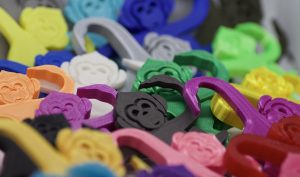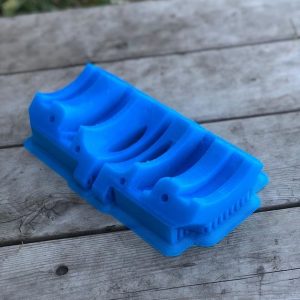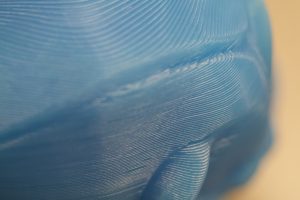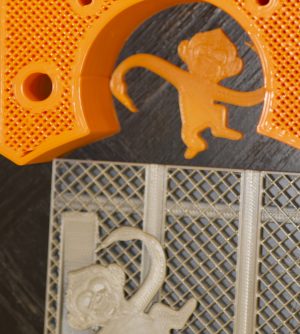How It Works
How 3D printing works:
Our monkey powered printers are SLA or Stereolithography apparatus aka laser power (pew pew) and FDM aka fused deposition modeling (think robots and a hot glue gun).
How do we do it? Magic! Just kidding. We take your 3D file and use software to slice it into layers. The printers then deposit each layer one at a time to build up your object.
SLA-Pros: High resolution, dimensional accuracy & detail
Cons: Higher cost and limited materials & colors
FDM-Pros: Vast material choice, economic and strong.
Cons: Lower resolution, limited to thermoform plastics.
Materials
PAY ATTENTION – This is where we get the MOST questions. You want the model of your dreams think of your’re material choice.
The most common types of 3D printers run off of spools of plastic filament. We guard our spools with unicorns. These filaments can be made of many materials, the most common ones are listed below. If there is something you’re interested and we don’t feature it, please contact us and we will see how we can accommodate you, you spoiled monkey.

PLA
PLA- This is the most common plastic used in 3D printing. It has the widest range of colours available, and offers good dimension accuracy. We have our regular colour range as well as Premium Colours that offer extra shine, sparkle or luster. PLA is also offered in regular strength as well as high strength. PLA is also one of the few materials that we can offer in food safe, perfect for cookie cutters, rolling pins and chocolate molds. The down side of PLA is that it begins to soften at 60C so we don’t recommend leaving it in a car on a hot day. PLA is derived from corn or sugar cane and is compostable, though it needs 140F to breakdown in the centre of your compost pile.

ABS
ABS- This is the plastic that most people are familiar with, it makes up about 80 percent of the plastic found in everyday items. It is stronger than PLA but has a tendency to warp so dimension accuracy can be an issue. ABS can take much higher temperatures than PLA so this material is recommended for use in automobiles. We have many colours available as well as modified ABS with glass fibers, and even carbon fibre. ABS does not like UV light so we do not recommend it for outdoor use, for that see PETG, ASA or Copolyesters
PETG
PETG- This material is what most of the pop and water bottles are made out of. It is strong, dimensionally stable and UV stable. The downside is that it does not have as many colours available as PLA and ABS. It does offer some of the best translucent colours, and can withstand some heat so it’s perfect for lampshade, votive holder (with caution) and it makes really cool vases.
Co-polyesters
Co-polyesters- These materials are like PETG on steroids. They can take the heat of a dishwasher, resist many solvents, and are fairly strong. The downside of these materials is they have a higher cost than many of our conventional plastics.
Flexible plastics
This family of plastics have unique properties that allow them to remain flexible after they are printed. Making them perfect for action figures, living hinges, anything that needs to take a beating and bounce back. We have a variety of colours available and several durometers available so send us an email to learn more.
Nylons, Polypropylene, HIPS, PVA, Polyolefins, fibre filled materials
These are some of our industrial plastics. We offer these but we recommend them for individuals experienced with 3D printing. Due to the harsh environments these materials are used in, contact us so we can ensure we can pair a material to suit your needs.
SLA – Resins
Right now we are experimenting with this technology, so you can have any colour you want, as long as its grey. Inquire for additional colours and materials. But we promise it’s a really nice grey.
Quality

Since 3D printing is built up of layer upon layer of material, the thickness of the layers greatly affects the quality of the finished part. The thinner the layer height the greater the dimensional accuracy. This directly relates to print time. Thinner layers means more layers, which then takes longer to print. Many customers want the specific layer lines associated with the “3D printed look,” for them we recommend higher layer thickness. With thicker layers we use large nozzles which allow for faster prints, and in some cases this prints become stronger.
The SLA printer produces the smallest layers we have available, it uses a pool of liquid resin and a laser, pew pew, to make the layers. If you want a super high detailed print, this is the method to use.
Infill

Infill is the percentage of open space inside your print. One of the advantages of 3D printing is that we use only enough material to make the object you want. For something with simple geometry we can make it with 90 percent air on the inside, similar to a honeycomb. We generally recommend about 25 percent infill for most models but can go all the way to solid, though this is generally not recommended. Again our pricing structure is based on the material mass used, so the higher the infill the higher the price.
Uploading a 3D design
We are PRINTERS.
We love printing and we are excited to work with you and make your designs go bananas. To print with us simply upload your .OBJ, .STL or 3MF file. We can work with .STP, 3DDXF and others BUT not in our automatic system so send us an email.
We do not make the files but we can hook you up with fabulous artists that can. Do not let your inability to design get in the way of your dreams.
FAQ
Uploading a 3D Design
-
What file formats do we support?
To print with us simply upload your .OBJ, .STL or 3MF file. We can work with .STP, 3DDXF and others BUT not in our automatic system so send us an email.
-
How many files can you upload?
Our system supports the uploading of multiple files, but you are limited by how many objects can fit on the print bed at one time. If all your files don’t fit on one print bed, add each file to the cart separately.
Materials, Quality & Infill
-
What is the most common material?
PLA is the most common material in 3D printing. It comes in the widest range of colours, literally all colours of the rainbow, even Pantone. Glow in the Dark, oooh spooky, fabulous glitter, thermal colour changing and even Matte Colours, the possibilities are almost endless.
We are adding new colours all the time, and most special orders can be filled by our suppliers in 2-5 business days.
-
What is your strongest filament?
Well that depends… How do you plan on using it. Is it going to be hot? Is it going to be under water? Is it going to be in a vat of acid? You may be an evil scientist, we don’t judge. There are many criteria to be considered when pairing a material to your situation, much more than can be explained in a simple FAQ. Please contact us and one of our highly skilled Technical Monkeys, “they have diplomas,” will help choose the perfect filament for you needs.
-
What is the most common infill?
Typically we use 10-20% This is good enough for most situations. We can change the pattern and percentage to suit your special case. We tend to not go higher then 85% as this isn’t necessarily stronger, and can cause a whole bunch of detrimental effects.
-
What are your Quality Settings?
This is dependant on your needs, the SLA technology can get down to Micron level accuracy, but it comes at a cost, namely time. We have our most common settings set up in our quoter, we have higher tolerance levels available, but outside of industrial type applications they are not usually warranted. If you would like more details on this feel free to send us an Email or Phone Call.
Ordering
-
What payment types do you accept?
Most Major Credit Cards thru our online store. We can accept cash and cheque though this requires prior approval, and is not available online.
-
How long will it take to fulfill your order?
Generally we complete your print in 3-5 business days, but this is dependant on the materials being in stock. If we don’t have the materials in stock we will contact you and advice on additional lead times.
-
Who do you ship with?
For the Edmonton Area we partner with several local next day delivery services.
Outside of Edmonton we use Canada Post and Fedex.
We currently only offer shipping within Canada.
